As we continue to address the challenges of the COVID-19 pandemic, our region’s public workforce system is ensuring people and businesses get connected to resources.
Individuals that are out of work are turning to the workforce system for many of the benefits and services included in the Coronavirus Aid, Relief and Economic Security (CARES) Act of 2020. Businesses are continuing to reach out to us for assistance in identifying and implementing options to meet their evolving workforce needs.
Although much of this is uncharted territory, we continue to do our best to meet the needs of businesses and individuals so our region and economy can recover.
Please reach out if we can assist you.
Kevin Perkey
Chief Executive Officer
Response to Businesses
Layoff Aversion – Since the onset of the COVID-19 pandemic, our Business Services team has been contacted by 57 businesses considering layoffs or work-hour reductions or who have already made the difficult decision to temporarily lay off workers. To date, the largest number of companies are in manufacturing, and close behind are healthcare, construction, and other services (except public administration).
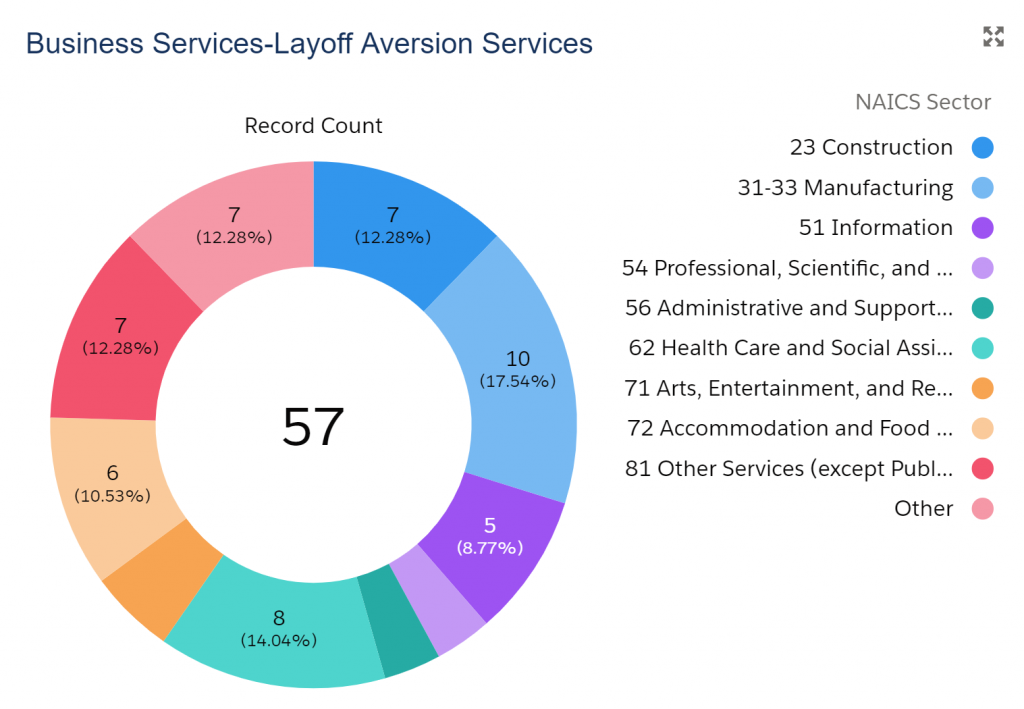
As we approach April 18, the date Employment Security will be ready to process CARES Act-eligible unemployment claims, the team is receiving more calls from those who are self-employed and sole proprietors.
Additionally, we are beginning to receive repeat calls from companies that we have previously advised on unemployment programs to provide further clarity and to troubleshoot denials employees are receiving from Employment Security. Companies are taking great care and consideration to choose programs that will offer their employees the greatest benefits as well as provide the highest likelihood to retain employees post-COVID-19.
Hiring – The business team has identified 25 companies in essential industries, including grocery, delivery and warehousing, that are hiring due to COVID-19. Open positions are advertised on our local WorkSource website. Job seekers are being directed to this site via WorkSource and social media to get directly connected to these opportunities.
The “retail trade” sector in the chart below is comprised of grocery and drug stores. These are part of the “essential businesses” allowed to remain operating during the Governor’s “Stay Home” order.
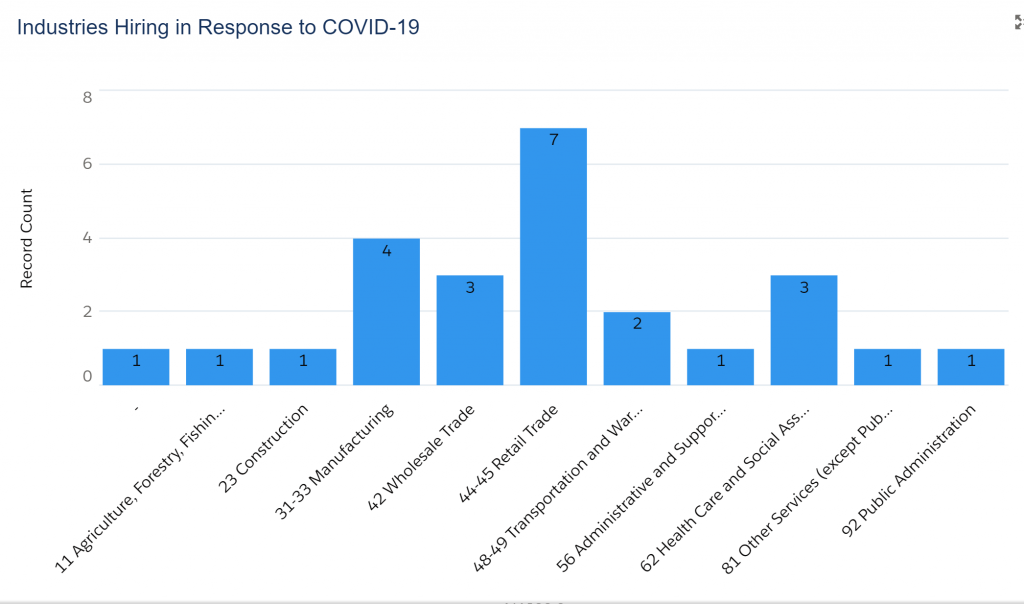
In the Online Job Postings chart below, the decline in job postings the weeks of March 9 and March 16 likely reflects concern and confusion over the growing COVID-19 threat. The sharp decline the week of March 23 can be attributed to the Governor’s March 23 “Stay Home” order. Increases in online job ads the weeks of March 30 and April 6 are essential businesses, such as grocery stores and delivery services, boosting hiring to meet demands of people staying at home.
Top occupations with online job postings were Laborers and Freight, Stock, and Material Movers. Top employers in Southwest Washington posting online job ads were Amazon, U.S. Army, Aerotek, Papa Murphy’s, and PeaceHealth. Top job titles were warehouse worker and warehouse associate.
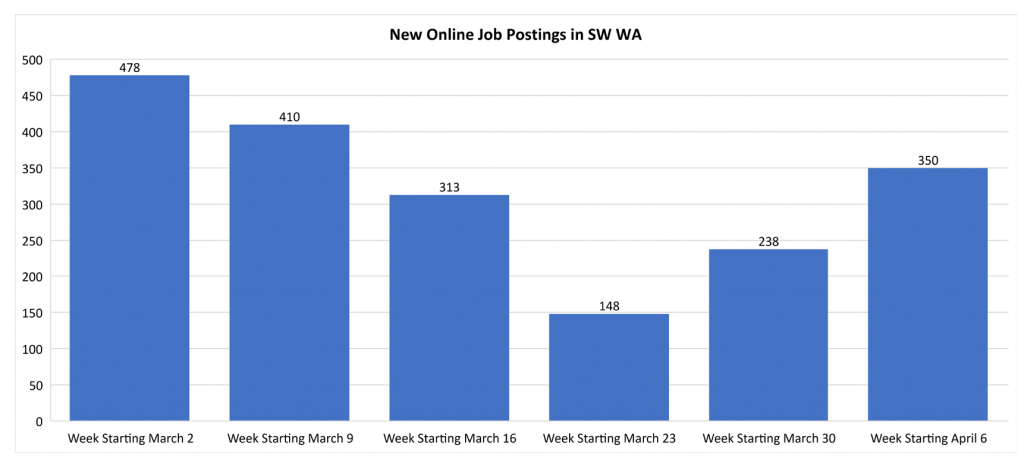
Top questions companies are asking us:
- My employees applied for unemployment, elected to use Standby because we intend to bring them back to work, but they are receiving denial letters from Employment Security, how should I advise them? The paperwork my company received from ESD accurately describes their employment situation so I’m not sure how to help?
- A: This is a glitch in ESD’s technology and they are working as quickly as possible to approve Standby claims that have been automatically denied. Advise your employees to continue filing a weekly claim.
- I am self-employed or have employees who work part-time; will people in these categories be eligible for unemployment insurance?
- Yes, it is highly likely that through the CARES Act, employees and self-employed people will be eligible for unemployment insurance. You can open a claim on or after April 18.
- I am self-employed, can I apply for the Paycheck Protection Program loan to support my own wages?
- Yes, but consider the terms and be sure to follow precisely to ensure loan forgiveness.
- If my employees are on the SharedWork program, will they be eligible to receive the additional $600 in Federal Pandemic Unemployment Compensation (FPUC)?
- A: Yes
- My bank doesn’t seem well-versed in SBA lending, could you recommend a lender?
- Yes, we have a list of approved SBA lenders
Assistance to People
WorkSource and Next continue to provide services virtually to adults and youth and are assisting customers by phone, email and video meetings.
WorkSource
The Customer Appointments chart shows the number of people requesting services from WorkSource. The Services chart below that shows what they are calling about. During the week of April 6, WorkSource staff assisted 826 people, 218 people more than the previous week.
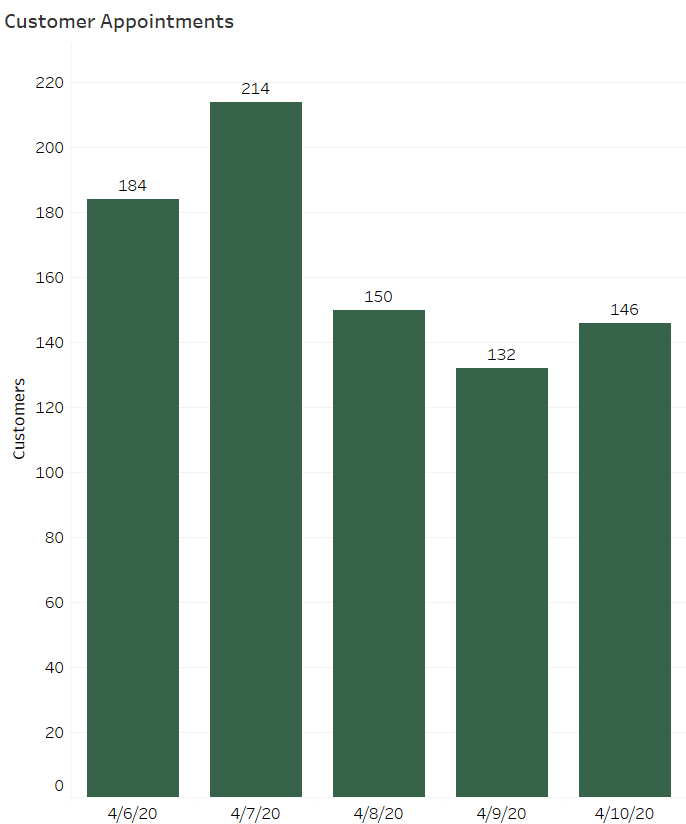
Unemployment continues to be the largest source of customer questions and requests with an average of approximately 140 customer inquiries per day in Vancouver and approximately 57 per day in Kelso.
The number of individuals seeking assistance with RESEA (Reemployment Services and Eligibility Assessment program) funded by the U.S. Department of Labor to help unemployment insurance claimants return to work faster more than doubled to 75, from 36 the prior week.
Services 4/6-4/10/2020
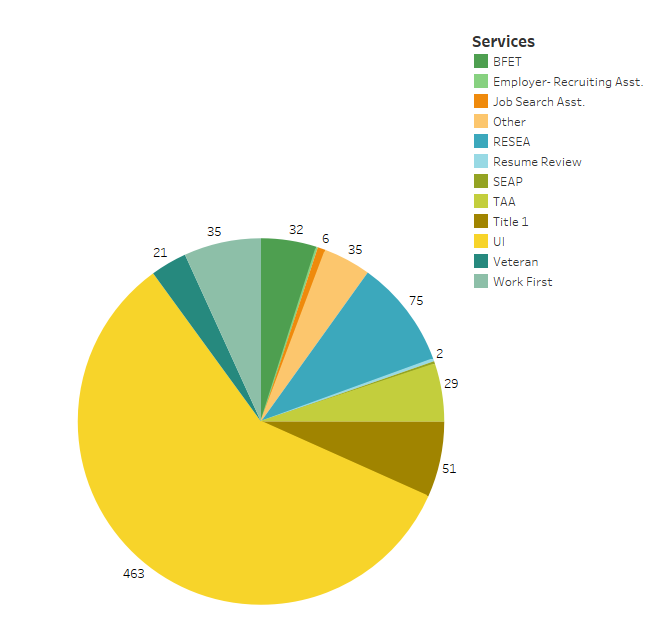
To reach as many customers as possible with information about services, brochures have been developed in Spanish and Russian and the team has distributed Spanish workshop content.
“I want to thank you for all your help and encouragement. The workshops at WorkSource have all been very informative but I’ve enjoyed attending yours the most. I feel so incredibly blessed to be hired at a time when so many people are being laid off and I believe you deserve some of the credit. Keep doing what you do, you’re changing lives!”
– Customer was laid off from Evergreen School District and recently hired at the VA
Workshops 4/6-4/10/2020
SW Washington’s WorkSource team has become a source of best practices for virtual service delivery. The team has provided partners across the state with ideas and information about how to best serve customers in a virtual environment.
- Since closing the offices for in-person services on March 18, WorkSource has had 806 attendees to its online webinars, with 427 of them being unique attendees.
- Individuals from 65 cities in both Oregon and Washington have participated in our SW WA virtual workshops, with a high of 100 customers in a single workshop.
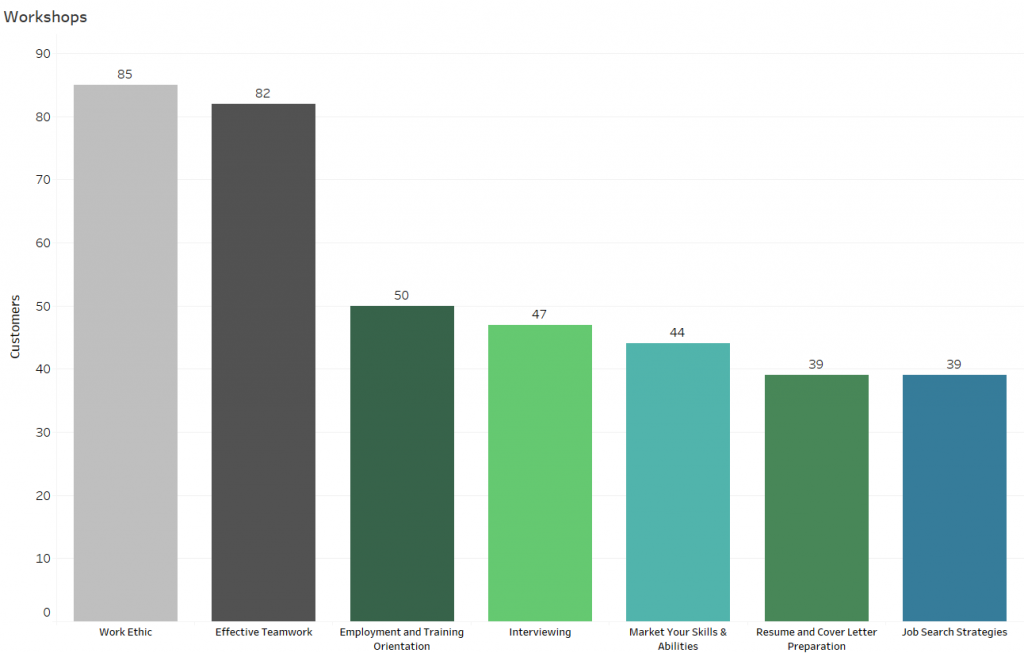
“Joseph is an incredible and intuitive instructor! He is very gifted in imparting his knowledge and makes the participant feel encouraged and unafraid to share without fear of being judged. This is the first Strategies for Success module I have attended and I found it very helpful and informative. I would have enjoyed it more had we been able to participate in person but due to the circumstances,
I am so glad that this did not keep me from attending.”
– From Strategies for Success workshop participant
Next Youth Center
The COVID-19 pandemic altered the way Next functions and staff are being creative and finding new ways to serve our community’s youth. Staff continue to develop and enhance offerings through social media, interactive and educational video experiences, and digital communication outreach.
- More than 75 youth reached out in the past two weeks for assistance planning their education, GED prep, technology, resumes, medical needs, transportation and help with unemployment benefits and employment opportunities.
- 55 youth requested assistance with GED.
- Other inquiries and requests were: Title 1: 25 youth, virtual tutoring: 11, support with job search: 12, orientation: 6
- Youth are also asking for assistance with information on taxes, how to handle rent increases, and how to get required hours to receive services through DSHS
- Classes have been reformatted to be delivered virtually and videos created on a variety of job search and employment topics to help youth continue their learning and progression toward self-sufficiency.
- Staff have created videos of workshops on sectors and entrepreneurship and posted them on social media, YouTube and the website. They’ve been viewed more than 140 times so far, with healthcare and entrepreneurship being the most popular.
Unemployment Claims
According to the WA State Employment Security Department (ESD), during the week of April 5-11, there were 143,241 initial and 585,983 total claims for unemployment benefits. While initial claims declined 16 percent from the previous week, it was still the third highest weekly number on record and five times more claims than the peak week during the Great Recession. Total weekly claims are now the highest on record.
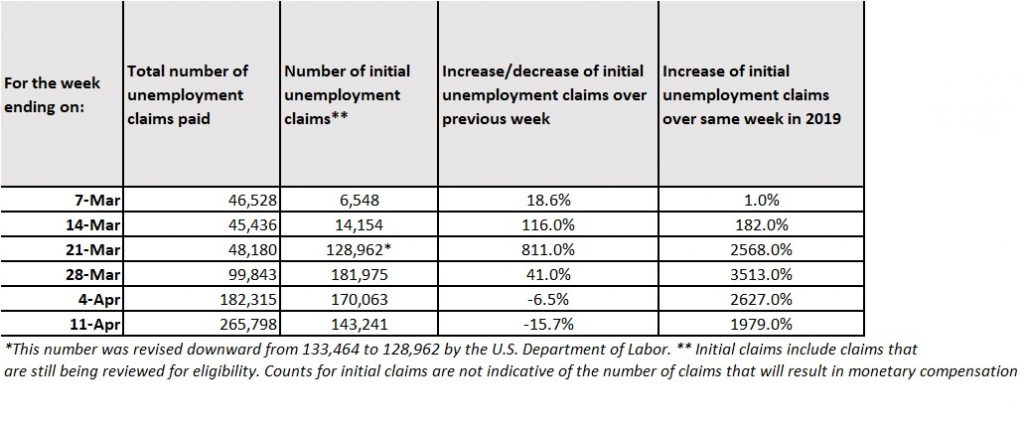
Since the week ending March 21, our three SW WA counties have seen 37,103 total initial claims for unemployment insurance (UI). The industries most impacted are: Accommodation and Food Services, Healthcare and Social Assistance, Retail Trade and Construction
Between the week of 3/29-4/4 and 4/5-4/11:
- Clark County: initial UI claims filed decreased to 5,991 from 9,378, down 40 percent
- Cowlitz County: decreased 40 percent with claims of 1,330 down from 2,215 the prior week
- Wahkiakum County: claims decreased more than 24 percent from 45 UI claims to 34
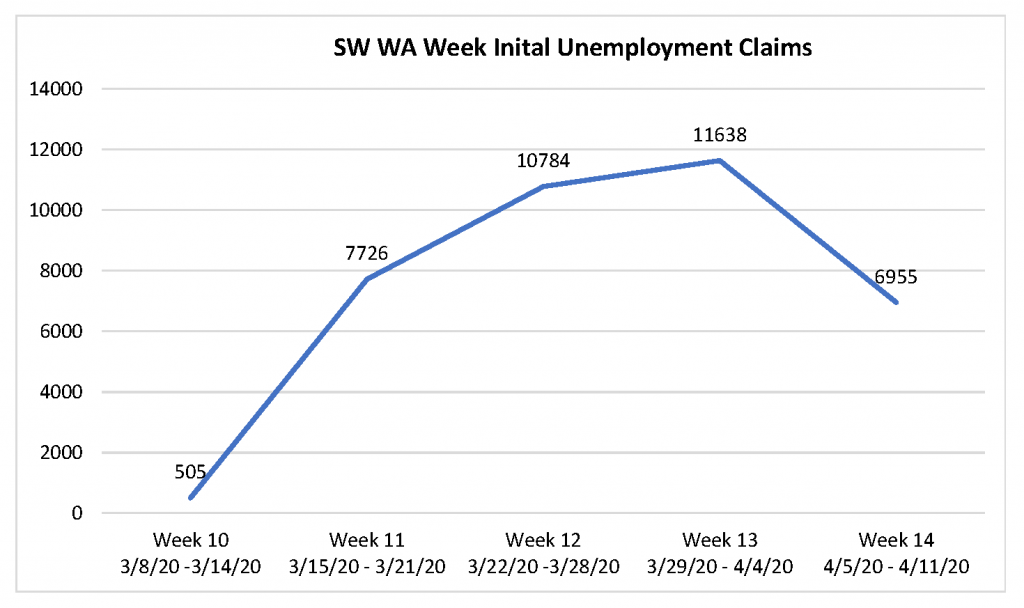
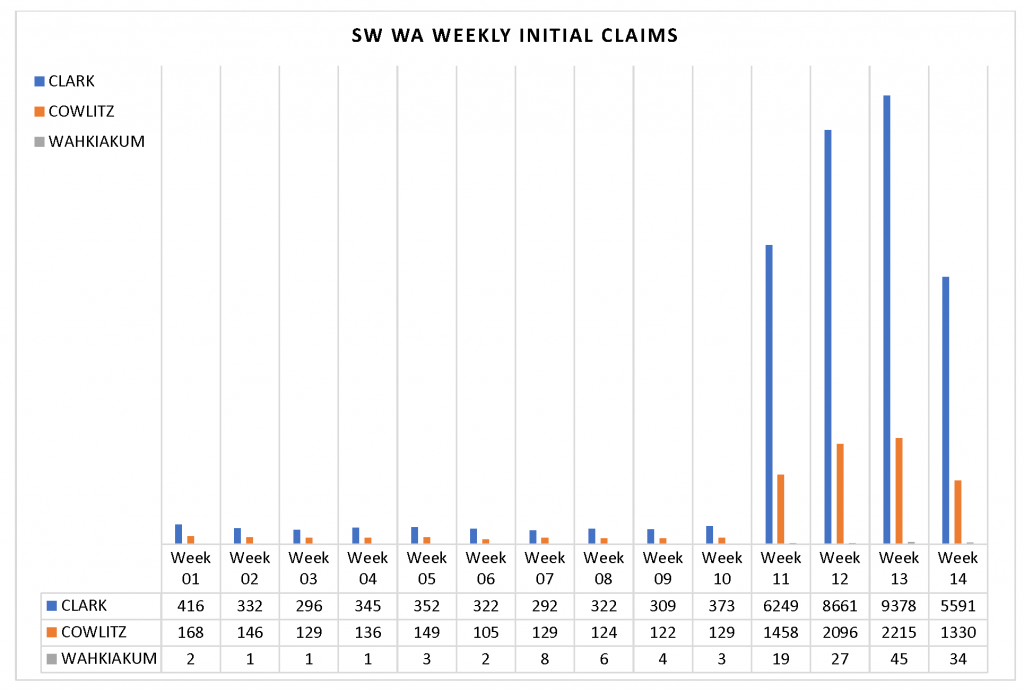
By Industry

Clark County industry sectors experiencing the highest number of initial claims March 9-April 11 were:
- Accommodation and food services: 4,372 initial claims
- Health care and social assistance: 4,202 initial claims
- Construction: 3,276 initial claims
- Retail trade: 2,926 initial claims
- Manufacturing: 1,758 initial claims
According to Regional Economist Scott Bailey with the Washington Employment Security Department:
- Health care claimants came predominantly from outpatient clinics (499). Within manufacturing, fabricated metals (47), nonmetallic mineral products (which includes cement/concrete production, 45), and machinery (43) had the largest number of claims.
- Over the past five weeks (March 8 through April 11), 30,383 initial claims were filed by county residents. Accommodations & food services (primarily from food services) continued to have the most total claims at 4,458, followed by health care & social assistance (primarily from outpatient clinics) with 4,202. Construction workers filed 3,276 claims and retail staff filed 2,926 claims. The large number of claims from an unknown industry are mostly interstate claims filed by Clark County residents who worked in another state.
- The largest occupational group filing claims was again management (698 claimants), in specific occupations like sales managers, marketing managers, construction managers and food service managers. Close behind were construction trades (625), office and administrative support occupations (582), sales occupations (556), food preparation and serving (506), and transportation & material moving (450)—the latter led by heavy truck drivers, bus drivers and laborers who move freight, stock and other materials.

Cowlitz County industry sectors experiencing the highest number of initial claims March 9-April 11 were:
- Health care and social assistance: 1,110 initial claims
- Accommodation and food services: 1,042 initial claims
- Construction: 901 initial claims
- Manufacturing: 537 initial claims
According to Regional Economist Scott Bailey:
- The top five industries remained the same as last week: health care & social assistance had the most at 190, followed by construction at 188, retail trade at 155, accommodations & food services at 125, and manufacturing with 102. Other industries with a substantial number of claims: business services with 66, arts, entertainment & recreation with 47 and other services (which include repair & maintenance services and personal services like hair styling) with 63.
- Over the past five weeks (March 8 through April 11), 7,263 initial claims were filed by county residents. Health care & social assistance workers had the most filings at 1,110, primarily from outpatient clinics (662), closely followed by accommodations & food services with 1,042 claims. Construction workers filed 901 claims. The large number of claims in the not disclosed category is mostly interstate claims filed by Cowlitz County residents who worked in another state.
- The largest occupational group filing claims in the past week was construction trades with 172. Management occupations, office and administrative support occupations and sales-related occupations all had 122 claims, while food preparation and serving occupations also had a high number with 118.

Wahkiakum County initial claims March 9-April 11 were 128, of which 113 did not disclose an industry.
By Industry (Washington State)
In Washington State, industry sectors experiencing the highest number of initial claims April 5-11 were:
- Manufacturing: 33,337 initial claims, up 20,364 initial claims from prior week
- Construction: 17,291 initial claims, down 7,103 initial claims from prior week
- Retail trade: 15,911 initial claims, down 4,597 initial claims from prior week
- Health care/social assistance: 12,783 initial claims, down 6,679 initial claims from prior week
- Accommodation/food services: 11,233 initial claims, down 6,784 initial claims from prior week
Industry sectors experiencing the highest percentage increase of initial claims April 5-April 11 were:
- Manufacturing: 33,337 initial claims, up 157 percent from prior week
- Public administration: 1,840 initial claims, up 69 percent from prior week
System priorities
- WSW is developing a workforce survey to businesses to help gain some insight as to how businesses anticipate recovery and their ability to rehire workers. The survey will be used to shape targeted industry conversations to develop specific strategies to support workers and businesses in the next 12 months. Additionally, we continue to stay on top of the latest updates from the State of WA Employment Security Department, Small Business Administration, Labor & Industries and the new Washington Small Business Emergency Grants (WWSBEG) that are being administered by our economic development councils locally.
- Providing information and assistance to as many companies as possible so that they can learn about and implement the best programs for their business and their employees is a primary objective. Virtual events continue to be highly effective in communicating broadly to our local business base. WSW has connected to hundreds of businesses in Southwest Washington by participating in virtual business convenings and community conversations to share the latest information on available resources. Including: CREDC+WSW Business Resource Zoom events, Congresswoman Jaime Herrera Beutler’s Town Hall, Food Northwest’s membership call, and Thursday afternoon April 9, we will present at the Port of Vancouver’s Tenant Town Hall.
- The Washington Workforce Association (WWA) has convened a statewide team of business services leaders from each of the 12 workforce development councils to create a solution to provide single-point-of-contact access to the public workforce system and align service delivery for statewide employers (examples: Providence, Boeing, etc.). The team plans to use WSW’s Launchpad CRM as a way to communicate business needs statewide.



